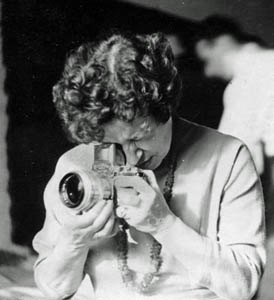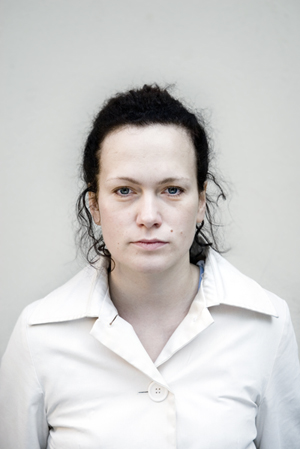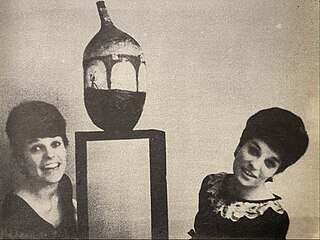
Jarosław Kukowski is a Polish contemporary painter, juror of international art competitions. His works were exhibited, among others Branch Museum of the National-Królikarnia Salons Rempex Auction House, the Museum of Galicia, the Contemporary Art Gallery, Castle Voergaard, the Art Expo New York and many other galleries and museums in the world. He is considered one of the most influential contemporary creators of the Surrealist circle.

Alina Szapocznikow was a Polish artist and Holocaust survivor. Recognized as one of the most important Polish sculptors of the post-war era, Szapocznikow utilized diverse and experimental mediums to investigate and examine the human form, recalling genres such as surrealism, nouveau realism, and pop art. Born in 1926 in Kalisz, Poland, into a Jewish family, she grew up Pabianice near Łódź. Her childhood was disrupted by the outbreak of World War II. Szapocznikow was later imprisoned in the Nazi concentration camps at Auschwitz and Bergen-Belsen before being transferred to Terezin in 1943.
Peter Grzybowski was a Polish multimedia and performance artist and a painter. He studied at the Faculty of Painting of the Academy of Fine Arts in Kraków (ASP), graduating in 1982. He first performed in 1981. He was a figure in the Polish performance art movement of the 1980s, performing individually and with Awacs Group (1982–87) and KONGER (1984–1986). From 1985 he lived in the USA.

Jacek Sempoliński was a Polish painter, draftsman, art professor, critic, and essayist.
Zuzanna Janin, is a Polish visual artist and former teenage actor. Janin lives and works in Warsaw and London. Janin has created sculpture, video, installation, photography and performatives. She used the names Zuzanna Baranowska (1990-1992) and from 1992 Zuzanna Janin. Her work was shown in the Museum of Contemporary Art, Chicago; and A.I.R Gallery New York. She is included in Feminist Artists Data in Brooklyn Museum, NY.
Koji Kamoji is a Japanese/Polish contemporary artist, who lives and works in Warsaw, Poland.
Tomasz Jerzy Vetulani is a Polish painter, drawer and sculptor. Born and educated in Kraków, he moved to Utrecht in 1991, and he has been active there since, holding also a citizenship of the Netherlands. In his works, using among others silicone and sponge, he includes both personal references and comments on current political and social issues.

Natalia Lach-Lachowicz was a Polish artist who worked with paint, photography, drawing, performance, and video art. Sean O'Hagan, writing in The Guardian in 2017, described her as "a neglected early-1970s Polish-born pioneer of feminist avant garde image making".
Paweł Kowalewski – is a Polish artist, member of Gruppa, pedagogue, founder of the Communication Unlimited agency.

Zofia Rydet was a Polish photographer, best known for her project "Sociological Record", which aimed to document every household in Poland. She began working on "Sociological Record" in 1978 at the age of 67, and took nearly 20,000 pictures until her death in 1997. Many of the pictures remain undeveloped. The photographs are predominantly portraits of children, men, women, couples, families and the elderly amidst their belongings. Rydet tended to photograph her subjects straight-on, using a wide-angle lens and a flash.

Magda Bielesz – painter, author of installations, objects, drawings, videos.
Agnieszka Kurant is a Polish interdisciplinary conceptual artist. She examines how economic, social, and cultural systems work in ways that blur the lines between reality and fiction.
Marek Kijewski and Małgorzata Malinowska, Polish artists, were cooperating since 1996 as Kijewski/Kocur duo in Warsaw, Poland. They often worked in the studios of the Centre of Polish Sculpture until the artist's death in 2007. Their works, in Polish art, was inspired by pop art and it showed the most distinct example of using pop art in the era of post-modernist experiments and reactions to the new reality and new economic-cultural situation that was forming in Poland in the early '90s.
Warsaw Gallery Weekend (WGW) – A yearly artistic event gathering selected private art galleries and organizing exhibitions and event.

Małgorzata Turewicz Lafranchi is a visual artist. Born in Poland, since 1994 she has lived and worked in Bellinzona in the Ticino canton of Switzerland.

Magdalena Więcek (July 23, 1924 in Katowice, Poland - December 31, 2008 in Dahab, Egypt) was a Polish sculptor and art teacher.
Katarzyna Karpowicz is a Polish contemporary painter.
Zofia Aleksandra Garlińska-Hansen was a Polish architect and co-author of the Open Form Theory (1957) as well as the Linear Continuous System (1967) with her husband, Oskar Nikolai Hansen. Zofia and Oskar worked together, producing architectural theory and built works primarily through the 1950’s and 1960’s.

Alicja Wahl was a Polish artist, also known for her contribution to the cultural life of Warsaw in the 80s and 90s.

Aleksandra Waliszewska is an artist from Warsaw, Poland, primarily working as a painter. Her surreal, horrific, highly symbolic, and sometimes gory work has been compared to Hieronymous Bosch and Francisco de Goya, and her style has been called "gothic". Informed by Balto-Slavic folklore such as the upiór, her paintings often depict supernatural figures in urban landscapes.










